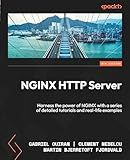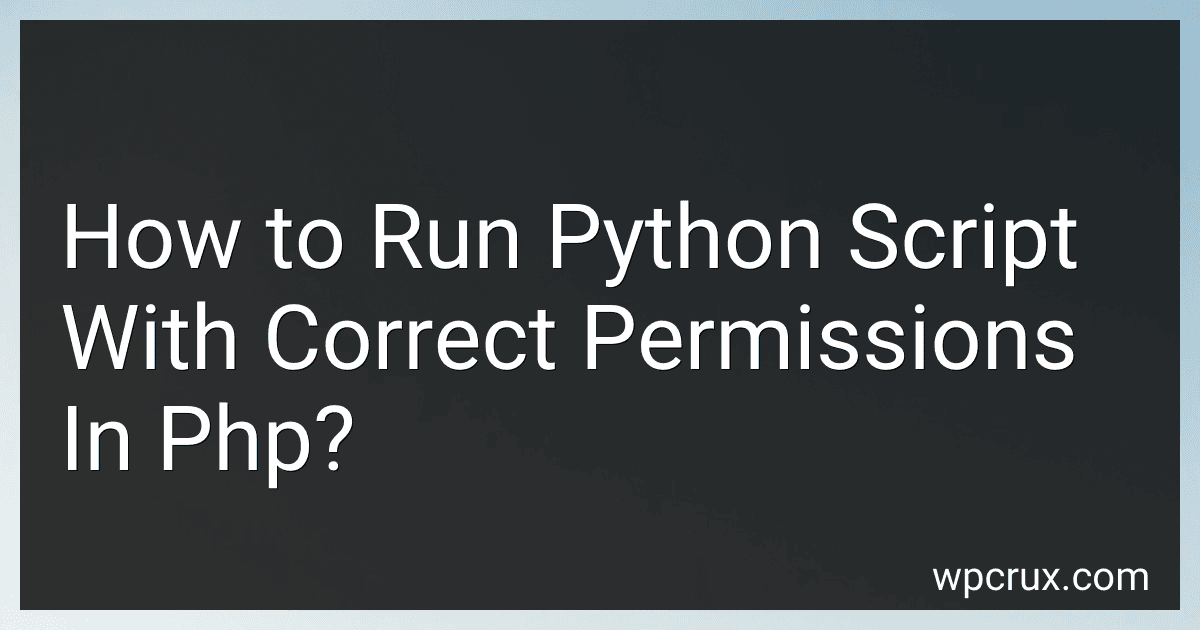Best Web Hosting Solutions to Buy in October 2025

Web Hosting For Dummies



Modern Web Development: A Beginner's Guide to HTML, CSS, Hosting, and SEO



Web Development with Blazor: A practical guide to building interactive UIs with C# 12 and .NET 8



The Ultimate WHM Guide (Web Hosting with cPanel)



A Moron's Guide to Web Hosting: On Amazon, Service, Servers and More



How to create website for beginners plus free domain and hosting



Strategies for Web Hosting and Managed Services



NGINX HTTP Server: Harness the power of NGINX with a series of detailed tutorials and real-life examples


To run a Python script with correct permissions in PHP, you can follow these steps:
- Identify the location of your Python script on the server. Make sure the file has executable permissions for the user running the PHP script.
- Use the PHP exec() function to execute the Python script. This function allows you to run shell commands and retrieve the output. The syntax is exec(command, output, return_var). Here, command represents the Python script execution command, output is an optional parameter to store the script's output, and return_var will hold the return status of the executed command.
- Construct the command that will execute your Python script. The basic structure is python . For example, if your Python script is located at /path/to/script.py, the command would be python /path/to/script.py. You may need to provide the full path to the Python interpreter if it's not in the system's default path.
- Add any necessary arguments or options to the command string. These will vary depending on your script's requirements. For example, if your Python script expects command-line arguments, you can include them in the command like python /path/to/script.py arg1 arg2.
- Save the output of the exec() function into variables if you need to use them in your PHP script. For example, exec($command, $output, $return_status) will capture any output generated by the Python script into the $output variable, and the return status into $return_status. You can then process or display these values as desired.
- Be cautious when executing Python scripts from PHP as it poses security risks. Validate and sanitize any user input before passing it to the Python script to prevent potential security vulnerabilities like code injection.
By following these steps, you can run a Python script with the correct permissions within your PHP environment.
What is the relationship between the PHP and Python execution environments while running a script?
PHP and Python are both server-side scripting languages, but they have different execution environments.
PHP is typically executed by a web server that has a PHP interpreter installed. When a request is made for a PHP script, the web server passes the script to the PHP interpreter. The PHP interpreter then parses and executes the script, generating HTML or other output that is sent back to the client.
On the other hand, Python scripts can be executed in a variety of ways. One common method is to run Python scripts using a Python interpreter installed on the server. The Python interpreter reads and executes the Python code line by line.
The execution environments of PHP and Python are independent of each other. They use different interpreters and have different runtime environments. It is not possible to directly run a PHP script using a Python interpreter or vice versa.
However, it is possible to integrate PHP and Python code within the same application. For example, a PHP script could make use of a Python module or library by executing the Python script as a separate process and capturing its output. This allows the two languages to coexist and interact within a larger application.
How to set up the correct environment to run a Python script with PHP?
To set up the correct environment to run a Python script with PHP, you need to follow these steps:
- Install Python: Install Python on your server or local machine. You can download the latest version of Python from the official Python website (https://www.python.org/downloads/) and follow the installation instructions.
- Verify Python installation: Open a command prompt or terminal and type python --version. It should display the installed Python version. Make sure it is successfully installed.
- Write the Python script: Create a Python script that you want to run with PHP. Save it with a .py extension. For example, create a script called example.py and write your desired Python code in it.
- Install PHP: Install PHP on your server or local machine. You can download the latest version of PHP from the official PHP website (https://www.php.net/downloads.php) and follow the installation instructions.
- Verify PHP installation: Open a command prompt or terminal and type php --version. It should display the installed PHP version. Make sure it is successfully installed.
- Set up a web server: Set up a web server like Apache or Nginx on your server or local machine. Follow the respective documentation to install and configure the web server.
- Create a PHP file: Create a PHP file that will execute the Python script. Save it with a .php extension. For example, create a file called run_script.php.
- Add PHP code: In the run_script.php file, add PHP code to execute the Python script. For example:
- Save the file: Save the run_script.php file in the appropriate directory accessible by your web server.
- Run the PHP file: Start your web server, go to your web browser, and access the run_script.php file using the server URL. It will execute the Python script and display the output in the browser.
By following these steps, you should be able to set up the correct environment to run a Python script with PHP.
What considerations should I make when running a Python script with PHP on different operating systems?
When running a Python script with PHP on different operating systems, you should consider the following:
- Compatibility: Ensure that the Python script and PHP code are compatible with the target operating systems. Check for any system-specific dependencies, libraries, or functions that may vary across platforms.
- File paths and separators: Be mindful of the file paths used in your scripts, as different operating systems use different file path separators (\ for Windows and / for Unix-like systems). Make sure the paths are handled correctly and consistently across platforms.
- Executing Python: PHP needs to have the necessary permissions to execute the Python script. Verify that the relevant executable (e.g., python or python3) is available and properly configured on each operating system.
- Environment variables: Python scripts might rely on specific environment variables, which can vary between operating systems. Ensure that the required environment variables are set correctly for each platform to avoid any script failures or unexpected behavior.
- Error handling: Different operating systems might have different error reporting mechanisms or error codes. Plan for any potential differences in error handling between platforms to handle them accordingly in your PHP code.
- File encoding: If your script deals with file operations or data encoding, be aware of the potential differences in text encoding across operating systems. Make sure the Python and PHP scripts handle these differences correctly to avoid any encoding-related issues.
- Third-party libraries: If your Python script relies on third-party libraries, ensure that these libraries are available and properly installed on each operating system. Take note of any platform-specific considerations or installation requirements for these libraries.
- Logging and debugging: Consider incorporating proper logging and debugging mechanisms to help identify and troubleshoot any issues that may arise on different operating systems. This can facilitate effective cross-platform development and troubleshooting.
Additionally, it is recommended to test your Python script with PHP on different operating systems to ensure its proper functionality and compatibility.
